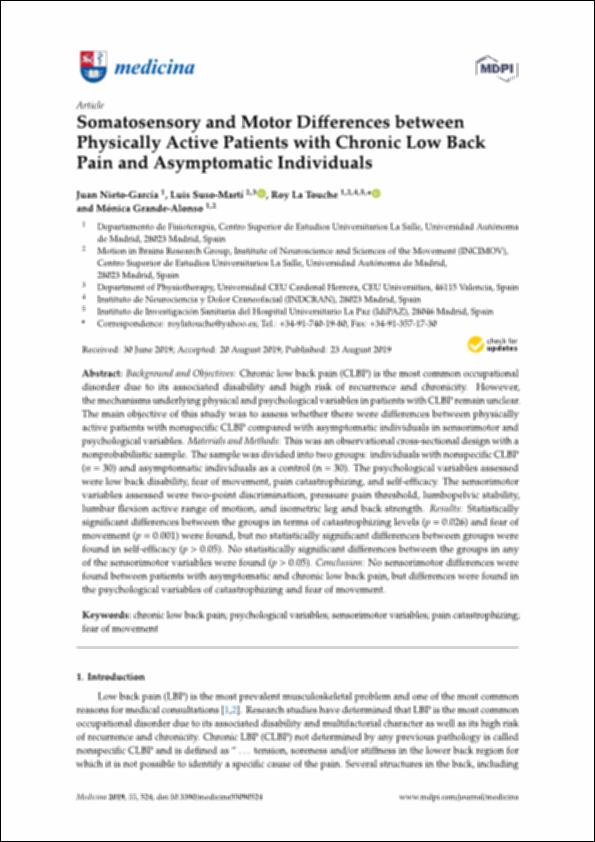Por favor, use este identificador para citar o enlazar este ítem:
http://hdl.handle.net/10637/10866Somatosensory and motor differences between physically active patients with chronic low back pain and asymptomatic individuals
| Título : | Somatosensory and motor differences between physically active patients with chronic low back pain and asymptomatic individuals |
| Autor : | Nieto García, Juan Suso Martí, Luis La Touche Arbizu, Roy Grande Alonso, Mónica |
| Materias: | Lumbago - Pacientes - Aspectos psicológicos.; Dolor de espalda - Pacientes - Aspectos psicológicos.; Backache - Patients - Psychological aspects. |
| Editorial : | MDPI : Lithuanian University of Health Sciences. |
| Citación : | Nieto-García, J., Suso-Martí, L., La Touche, R. & Grande-Alonso, M. (2019). Somatosensory and motor differences between physically active patients with chronic low back pain and asymptomatic individuals. Medicina, vol. 55, n. 9, art. 524 (23 aug.). DOI: https://doi.org/10.3390/medicina55090524 |
| Resumen : | Background and Objectives: Chronic low back pain (CLBP) is the most common occupationaldisorder due to its associated disability and high risk of recurrence and chronicity. However,the mechanisms underlying physical and psychological variables in patients with CLBP remain unclear.The main objective of this study was to assess whether there were differences between physicallyactive patients with nonspecific CLBP compared with asymptomatic individuals in sensorimotor andpsychological variables.Materials and Methods: This was an observational cross-sectional design with anonprobabilistic sample. The sample was divided into two groups: individuals with nonspecific CLBP(n=30) and asymptomatic individuals as a control (n=30). The psychological variables assessedwere low back disability, fear of movement, pain catastrophizing, and self-efficacy. The sensorimotorvariables assessed were two-point discrimination, pressure pain threshold, lumbopelvic stability,lumbar flexion active range of motion, and isometric leg and back strength.Results: Statisticallysignificant differences between the groups in terms of catastrophizing levels (p=0.026) and fear ofmovement (p=0.001) were found, but no statistically significant differences between groups werefound in self-efficacy (p>0.05). No statistically significant differences between the groups in anyof the sensorimotor variables were found (p>0.05).Conclusion: No sensorimotor differences werefound between patients with asymptomatic and chronic low back pain, but differences were found inthe psychological variables of catastrophizing and fear of movement. |
| Descripción : | Este es el artículo que se ha publicado de forma definitiva en: https://www.mdpi.com/1010-660X/55/9/524 Este artículo pertenece al número especial "Chronic Pain Management". |
| URI : | http://hdl.handle.net/10637/10866 |
| Derechos: | http://creativecommons.org/licenses/by/4.0/deed.es |
| ISSN : | 1010-660X (Electrónico). |
| Fecha de publicación : | 23-ago-2019 |
| Centro : | Universidad Cardenal Herrera-CEU |
| Aparece en las colecciones: | Dpto. Enfermería y Fisioterapia |
Los ítems de DSpace están protegidos por copyright, con todos los derechos reservados, a menos que se indique lo contrario.


